Senua's Saga: Hellblade 2 is a defining moment in the evolution of real-time graphics
The Digital Foundry tech review.
Senua's Saga: Hellblade 2 is a carefully paced cinematic game - almost like the logical conclusion of those early 90s FMV experiments. I mean that in the best way and I'm fascinated by its existence - in an era where it feels as if publishers are pushing to fill their games with arguably too many features, Hellblade 2 is a tight, pure experience more so than a typical video game. The focus is so tight, in fact, that some may be put off by the lack of interactivity, but let's be clear - it's his singular focus that allows it to shine, becoming its own thing that you won't soon forget. It's a masterpiece in audio-visual design from developer Ninja Theory and an astonishing demonstration of Unreal Engine 5's core technologies.
As a story-focused game, characters and character rendering play a significant role in the presentation. However, while the pre-release media largely focused on Senua herself, Hellblade 2 features a surprisingly large number of other humans. It's without doubt one of the games defining visual features - the character rendering in Hellblade 2 sets new standards, delivering sequences that, at times, almost resemble actual filmed scenes with real actors. This is one of the first examples of a game that stands up against the promise of the UE5 demo The Matrix Awakens. The scenes feel very natural and realistic in a way that manages to somewhat sidestep the uncanny valley almost completely.
When the camera zooms in for a close-up, the level of detail is such that it left me guessing whether I was looking at real-time graphics or a pre-rendered cutscene. Thankfully, with Photo Mode being available at any time, you can easily confirm that they are, in fact, real-time.Of course, it's really the animation you experience while playing that impressed me the most. The expressions visible while engaged in combat or simply exploring really help bring the characters to life.
If you stop and zoom-in with photo mode, there's a remarkable level of detail to appreciate at close range. Looking at Senua's face, the skin rendering is remarkable - the layers of dirt clogging her pores, the light penetrating the top layer via sub-surface scattering, the nearly perfect ambient and direct shadows - it's superb. Senua's bloodshot eyes simulate the layer of viscous fluid protecting it with just the right amount of specular - her eyes have actual depth. Then there's the fine details on her lashes or the small grouping of hair spilling out from her headdress. Without a doubt, Hellblade 2 features one of the best depictions of a digital human we've ever seen.
However, the realism is not achieved purely using detailed models. Other engines and games are perfectly capable of such feats. Where Hellblade shines is from the art side. The game attempts to simulate the use of an anamorphic lens with the focal effects that go along with it - there's a realism to it that genuinely gives you this feeling that what you're seeing has been filmed using a physical camera.
The use of film grain and chromatic aberration also work in tandem to heighten the filmic presentation. I know, these techniques aren't always popular in games and the option to disable them would be nice for those that genuinely get a headache from it, but I feel it's key to creating this soft, analogue-like presentation. It very specifically helps the game feel more naturalistic, something that extends to the PC version running in higher resolution. It's just intended to be a soft presentation and I do think it works in this specific case. It's not something I would want to see in most games but it works here, reminding me in a way of PS4's The Order: 1886. Both titles rely on soft, filmic image quality and both are also ahead of their time in terms of visual quality, I would argue.
Also, like The Order, Hellblade 2 is presented using a wider aspect ratio resulting in black bars on a 16:9 screen. You can zoom-in using photomode, curiously, but the game is intended to be viewed with the wider aspect ratio. This is where the talk of resolution comes in - as reported pre-release, the final game also presents in the 1296p to 1440p range, which is technically 964p to 1070p when taking the black bars into account. This is on Xbox Series X, I should mention - we'll have more info on Series S in a following piece but on the Series X, Hellblade recalls the musings of Timothy Lottes, inventor of FXAA, more than a decade ago where there was discussion over sharpness versus a lower resolution, more filmic output comparable to a Blu-ray movie. That's the look Hellblade goes for and I do think it succeeds.
Hellblade 2 is one of the Unreal Engine 5 games to ship that takes full advantage of everything the engine has to offer to produce visuals that feel like a genuine leap forward. So how does it manifest? Firstly, there's Lumen global illumination. Hellblade 2 is a game that relies primarily on natural lighting split between natural sunlight and light sources such as fire. Hellblade 2 is largely a dark game but there are scenes which take place during the day and Lumen allows very natural indirect and direct lighting. As the lighting is entirely real-time without a baked component, this also allows the developers to pull off some fancy visual tricks. For instance, when there is a time jump, the game can pull the camera out and shift the position of the sun in real-time. Shadows and indirect lighting update accordingly enhanced by the volumetric cloud sim above.
Lumen reflections are also in use on shiny surfaces such as pools of water, though it would appear to be using the software Lumen path (as opposed to hardware-accelerate ray tracing) as the reflections visible beneath the layered screen-space reflections exhibit obvious SDF artefacts. The only issue with this configuration is that screen-space reflections can cause issues with certain dynamic objects such as when carrying your torch through sunken ruins - it reflects across the surface unrealistically due to the use of SSR. What's neat is that thanks to the fully real-time lighting, the photo mode even allows players to add lights into a scene and manipulate them in real-time. Suddenly, photo mode itself behaves more like an actual film shoot where you can manually place key lights to get the best shots.

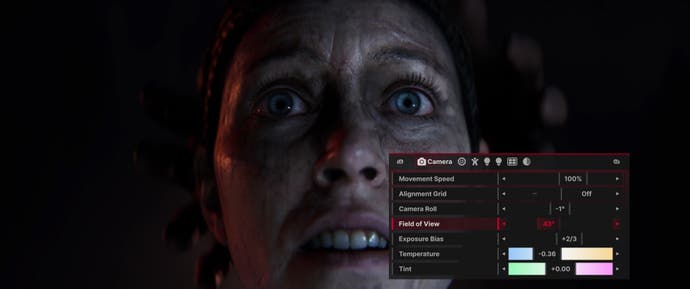
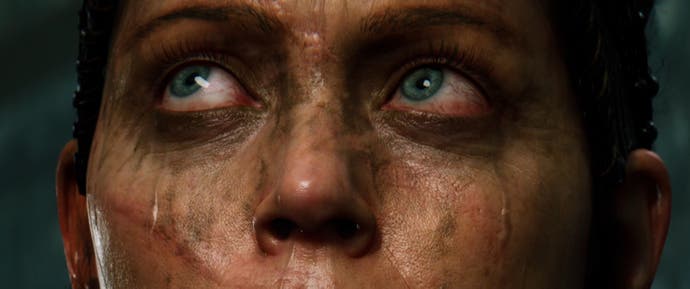
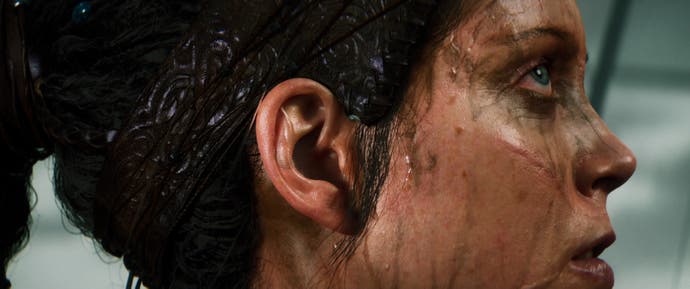
For most players, the nuts and bolts of Lumen aren't that important, rather, it's what it produces that matters and I think anyone just looking at the game in motion will be impressed by the way scenes are lit even if they do not understand the technical details. It just looks 'right' to the eye which is the power of high fidelity GI.
Feeding into the lighting is the heavy reliance on environmental effects. For instance, the robust volumetric effects are a standout with many scenes exhibiting mist, low hanging clouds, smoke and more. Ninja Theory seems to combine Unreal's volumetric fog system with additional fog materials designed to give the impression of swirling smoke. You'll see these effects used across the entire game and the fidelity on Series X is kept impressively high with minimal break-up and noise.
Another effect that impressed me is the water - specifically the way it interacts with the environments. You begin the game washed up on a beach and I immediately appreciated the excellent visualisation of waves crashing on the shore. In that same scene, an intense rainfall fills the scene with beautiful particles that convincingly capture the feeling of inclement weather. The mix of rain and volumetrics is simply beautiful, but I was equally impressed by the game's water streaming system - which often falls short in even some of the most high-profile triple-A titles. There's even a scene where you drain a lake to reveal an underground passage which just looks amazing in motion.
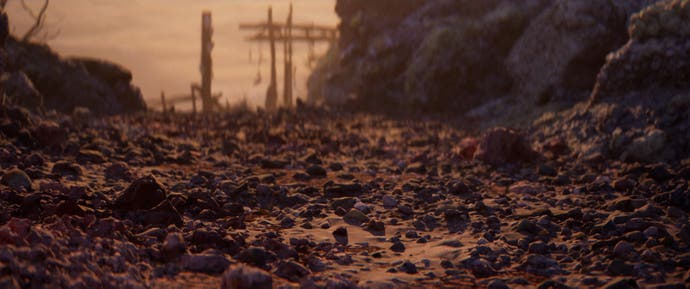
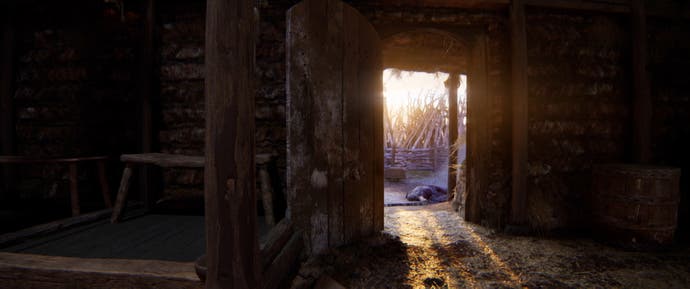
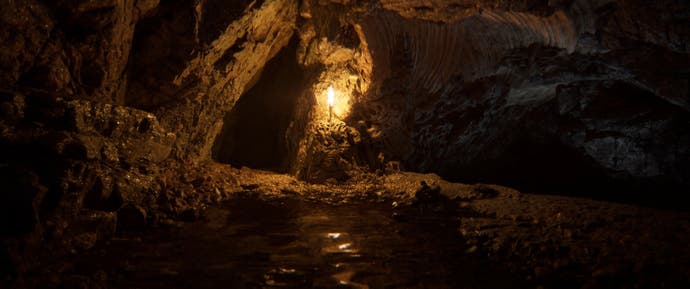
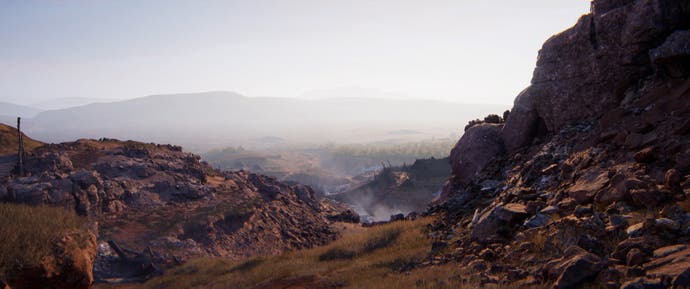
Then there's Epic's next-gen geometry system: Nanite. This is designed to allow extreme mesh density while virtually eliminating visible pop-in. That means that as you move through the game world, everything remains stable without asset draw-in and other distracting artefacts. That aspect by itself is deeply impressive and contributes to the photorealism on display. Ninja Theory really flexes this when transitioning between different scenes: as the camera swoops down from above, there is simply no visible pop-in within the presentation - a rare thing when moving at speed over vast vistas.
Nanite also helps the artists create large-scale scenes with minimal repetition and tiling. The assets themselves rely on scanned photogrammetry assets based on various trips the team took during development. Interestingly, the locale of choice for this game is a perfect match for the initial release of Unreal Engine 5 - that is, lots of rocks. Of course, Hellblade does feature scenes with foliage, but a lot of the game world reminds me of that initial tech demo and it's cool to see it come to fruition in a shipping game. That's not to say everything is flawless here - the scenes look their best from the normal gameplay perspective but if you stop and zoom in, you will certainly notice limitations in the raw assets at times. In other scenes, things hold up much better, but it is something you might notice when poking and prodding. This isn't really a complaint, however, and it doesn't negatively affect the in-game visuals - just an observation. I think this is more a limitation of manpower and time than anything else.
Still, all of this geometry is nicely enhanced by the use of virtual shadow maps - another key UE5 feature. The idea behind VSM is to increase the resolution of shadows to reflect the dense geometry of Nanite-driven scenes and character models. If you zoom-in to small scale objects, the game is able to retain fine shadow detail without any of the usual issues we associate with traditional shadow maps. The key here is that VSMs are fully unified, with all shadows handled this way, removing the need for different types of shadows which often sit awkwardly when combined in the same presentation.
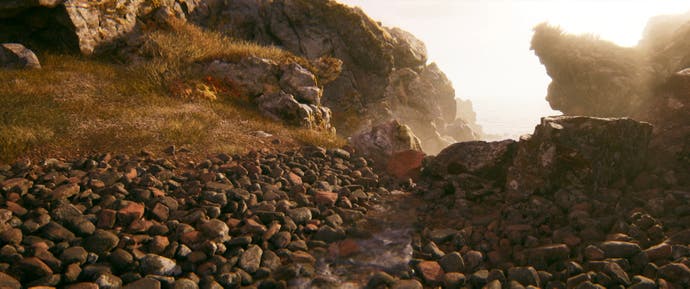

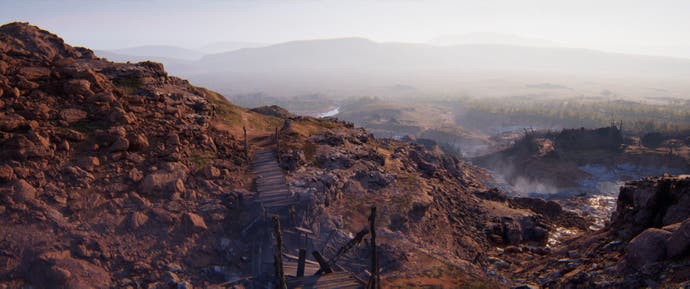

The real magic stems from the combination of all these techniques by the game's artists. This isn't the first shipping game to use these features but it is, arguably, the best looking example we've seen thus far. Of course, all of this does come at a cost - frame-rate but this topic is a little tricky regarding a game like this. So, as has been known for a while, Hellblade 2 is limited to 30 frames per second on Xbox consoles. It does reach this target flawlessly in my experience with virtually zero hiccups - it runs at 30fps and 30fps is exactly what you'll get from start to finish.
However, the conversation around this target is more delicate and a matter of opinion. I do genuinely believe that certain types of presentations work well at 30 fps and Hellblade is one of those games but not everyone is going to be onboard with this. Could the game achieve 60fps? We tested the PC version using a bespoke rig built around the AMD 4800S desktop kit - literally the Series X CPU in PC form - paired with the RX 6700 10GB, a GPU with key architectural similarities to PS5's graphics core. Reducing resolution and quality settings got us to an unstable 60fps - good enough for VRR, perhaps - but it's clear that the assets are built from the ground up with a 30fps target in mind for this class of hardware. We'll have more on the PC version in a follow-up article.
Of course, there is more to this presentation than just visuals - audio plays a huge role as well and Hellblade 2 specifically takes a very different approach compared to most games. So, one of the key elements are the voices Senua hears throughout the game is basically the manifestation of psychosis, really. To that end, like the original, Ninja Theory relies on Binaural audio and suggests playing the game in headphones. While I would say the home theatre experience is excellent, it's true that the effect works best with headphones.

The idea of binaural audio is to simulate the physical characteristics of our ears and the way sound enters the ear canal. By duplicating this via recording with a head mic or some other technique, it helps create the illusion. What this means for Hellblade is that, as the voices speak to the player through headphones, it genuinely gives the impression that there is someone directly whispering in your ears or around your head. It's remarkably immersive. The overall audio presentation beyond the voices is equally impressive.
So when it comes to presentation, I would say that Hellblade 2 stands among the best looking games ever created. It's a great fusion of UE5 and Ninja Theory's talented art team. Everything about the presentation feels polished to perfection.
It's an interesting release in that sense as the team decided to focus in on the experience aspect of the original while delivering that at the highest possible fidelity and that's become central to the discussion. Basically, Hellblade 2 is less of a typical game and more of something that washes over you. It's a style of release not unlike Cyan's original Manhole - where some would argue it's barely a game but others would agree that the journey is worth taking.
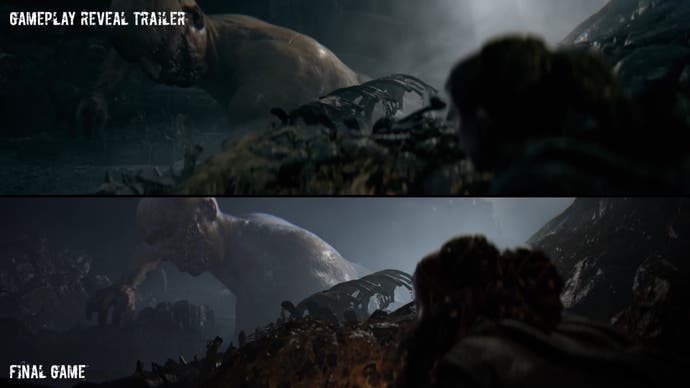
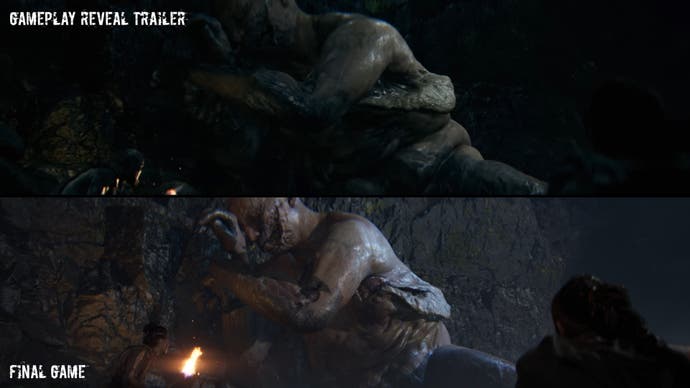
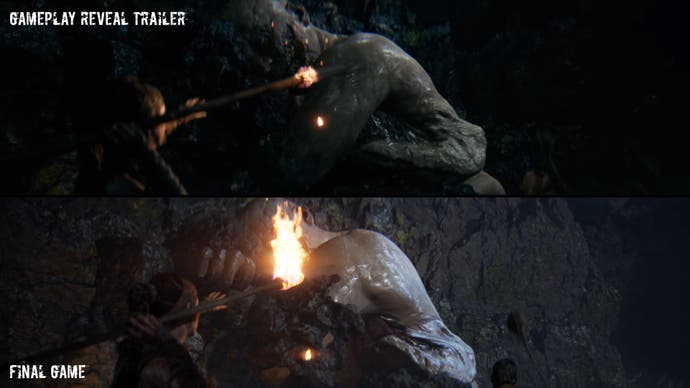

So, I wanted to break down why the game is considered as such and I think it boils down to lack of control agency. It's an interesting release in that sense as the team decided to focus on the experience aspect of the original while delivering that at the highest possible fidelity and that's become central to the discussion.
I think the reason it doesn't resonate with some might come down to expectations. Hellblade 2 is a story-driven experience more than what one might think of as a typical game, let alone a triple-A juggernaut. This is evident in how input is handled - there are many scenes where you push up, watch an animation play out, then push up again when that animation is finished. In combat, the game regularly takes control out of your hands - you press buttons to attack and when you've drained enough life, the game will play a finisher animation before bringing in the next enemy. Most of your time with Hellblade 2 involves walking or watching.
And frankly, I think it's great that such an experience can be made at this level of fidelity. Whether it's for you or not is down to personal taste but what is here has been executed perfectly and that deserves kudos. Ninja Theory has made one of the most technically accomplished examples of real-time graphics we've seen to date and it absolutely should be experienced.



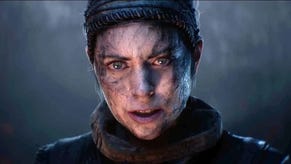

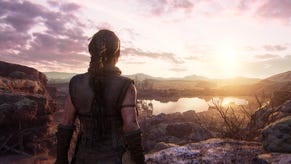


.jpg?width=291&height=164&fit=crop&quality=80&format=jpg&auto=webp)